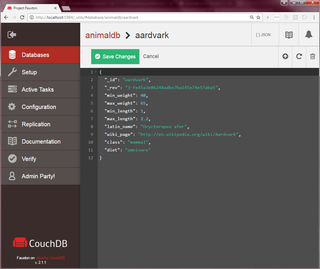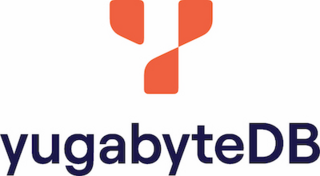
MySQL is an open-source relational database management system (RDBMS). Its name is a combination of "My", the name of co-founder Michael Widenius's daughter My, and "SQL", the acronym for Structured Query Language. A relational database organizes data into one or more data tables in which data may be related to each other; these relations help structure the data. SQL is a language that programmers use to create, modify and extract data from the relational database, as well as control user access to the database. In addition to relational databases and SQL, an RDBMS like MySQL works with an operating system to implement a relational database in a computer's storage system, manages users, allows for network access and facilitates testing database integrity and creation of backups.

Db2 is a family of data management products, including database servers, developed by IBM. It initially supported the relational model, but was extended to support object–relational features and non-relational structures like JSON and XML. The brand name was originally styled as DB2 until 2017, when it changed to its present form.
MySQL Cluster is a technology providing shared-nothing clustering and auto-sharding for the MySQL database management system. It is designed to provide high availability and high throughput with low latency, while allowing for near linear scalability. MySQL Cluster is implemented through the NDB or NDBCLUSTER storage engine for MySQL.
The following tables compare general and technical information for a number of relational database management systems. Please see the individual products' articles for further information. Unless otherwise specified in footnotes, comparisons are based on the stable versions without any add-ons, extensions or external programs.
Multi-master replication is a method of database replication which allows data to be stored by a group of computers, and updated by any member of the group. All members are responsive to client data queries. The multi-master replication system is responsible for propagating the data modifications made by each member to the rest of the group and resolving any conflicts that might arise between concurrent changes made by different members.

Apache CouchDB is an open-source document-oriented NoSQL database, implemented in Erlang.
HBase is an open-source non-relational distributed database modeled after Google's Bigtable and written in Java. It is developed as part of Apache Software Foundation's Apache Hadoop project and runs on top of HDFS or Alluxio, providing Bigtable-like capabilities for Hadoop. That is, it provides a fault-tolerant way of storing large quantities of sparse data.

Cassandra is a free and open-source, distributed, wide-column store, NoSQL database management system designed to handle large amounts of data across many commodity servers, providing high availability with no single point of failure. Cassandra offers support for clusters spanning multiple data centers, with asynchronous masterless replication allowing low latency operations for all clients. Cassandra was designed to implement a combination of Amazon's Dynamo distributed storage and replication techniques combined with Google's Bigtable data and storage engine model.
NoSQL is an approach to database design that focuses on providing a mechanism for storage and retrieval of data that is modeled in means other than the tabular relations used in relational databases. Instead of the typical tabular structure of a relational database, NoSQL databases house data within one data structure. Since this non-relational database design does not require a schema, it offers rapid scalability to manage large and typically unstructured data sets. NoSQL systems are also sometimes called "Not only SQL" to emphasize that they may support SQL-like query languages or sit alongside SQL databases in polyglot-persistent architectures.

Apache Hive is a data warehouse software project, built on top of Apache Hadoop for providing data query and analysis. Hive gives an SQL-like interface to query data stored in various databases and file systems that integrate with Hadoop. Traditional SQL queries must be implemented in the MapReduce Java API to execute SQL applications and queries over distributed data. Hive provides the necessary SQL abstraction to integrate SQL-like queries into the underlying Java without the need to implement queries in the low-level Java API. Since most data warehousing applications work with SQL-based querying languages, Hive aids the portability of SQL-based applications to Hadoop. While initially developed by Facebook, Apache Hive is used and developed by other companies such as Netflix and the Financial Industry Regulatory Authority (FINRA). Amazon maintains a software fork of Apache Hive included in Amazon Elastic MapReduce on Amazon Web Services.
Voldemort is a distributed data store that was designed as a key-value store used by LinkedIn for highly-scalable storage. It is named after the fictional Harry Potter villain Lord Voldemort.
Sherpa is a cloud storage platform developed by Yahoo!. It is a hosted, distributed, and geographically replicated key-value data store. The service is a NoSQL system that has been developed by Yahoo!, to address the scalability, availability, and latency needs of the conglomerate’s websites. Sherpa has abilities such as elastic growth, multi-tenancy, global footprint for local low-latency access, asynchronous replication, representational state transfer (REST) based web service APIs, novel per-record consistency knobs, high availability, compression, secondary indexes, and record-level replication.

Elasticsearch is a search engine based on the Lucene library. It provides a distributed, multitenant-capable full-text search engine with an HTTP web interface and schema-free JSON documents. Elasticsearch is developed in Java and is dual-licensed under the (source-available) Server Side Public License and the Elastic license, while other parts fall under the proprietary (source-available) Elastic License. Official clients are available in Java, .NET (C#), PHP, Python, Ruby and many other languages. According to the DB-Engines ranking, Elasticsearch is the most popular enterprise search engine.

Apache Drill is an open-source software framework that supports data-intensive distributed applications for interactive analysis of large-scale datasets. Built chiefly by contributions from developers from MapR, Drill is inspired by Google's Dremel system. Drill is an Apache top-level project. Tom Shiran is the founder of the Apache Drill Project. It was designated an Apache Software Foundation top-level project in December 2016.

Oracle NoSQL Database is a NoSQL-type distributed key-value database from Oracle Corporation. It provides transactional semantics for data manipulation, horizontal scalability, and simple administration and monitoring.
Database scalability is the ability of a database to handle changing demands by adding/removing resources. Databases use a host of techniques to cope.
TiDB is an open-source NewSQL database that supports Hybrid Transactional and Analytical Processing (HTAP) workloads. Designed to be MySQL compatible, it is developed and supported primarily by PingCAP and licensed under Apache 2.0. It is also available as a paid product. TiDB drew its initial design inspiration from Google's Spanner and F1 papers.
A distributed SQL database is a single relational database which replicates data across multiple servers. Distributed SQL databases are strongly consistent and most support consistency across racks, data centers, and wide area networks including cloud availability zones and cloud geographic zones. Distributed SQL databases typically use the Paxos or Raft algorithms to achieve consensus across multiple nodes.

YugabyteDB is a high-performance transactional distributed SQL database for cloud-native applications, developed by Yugabyte.
YDB is a distributed SQL database management system (DBMS) developed by Yandex, available as open-source technology.








